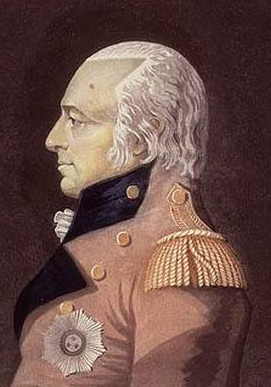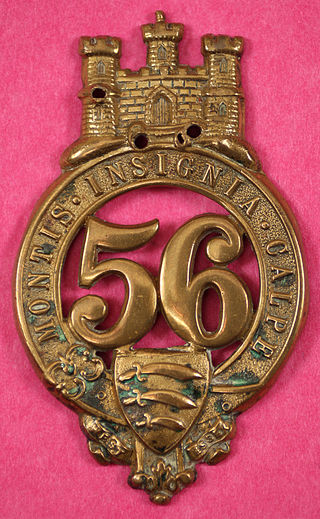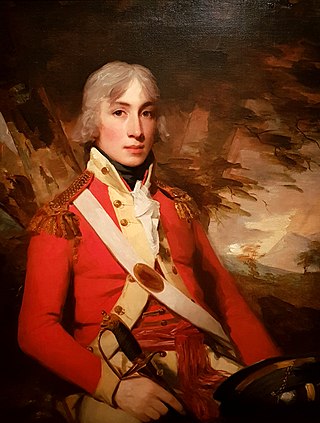Related Research Articles

General Sir James Henry Craig KB was a British military officer and colonial administrator.
The 96th Regiment of Foot was a British Army regiment, raised in 1798. Under the Childers reforms it amalgamated with the 63rd Regiment of Foot to form the Manchester Regiment.

The West India Regiments (WIR) were infantry units of the British Army recruited from and normally stationed in the British colonies of the Caribbean between 1795 and 1927. In 1888 the two West India Regiments then in existence were reduced to a single unit of two battalions. This regiment differed from similar forces raised in other parts of the British Empire in that it formed an integral part of the regular British Army. In 1958 a new regiment was created following the creation of the Federation of the West Indies with the establishment of three battalions, however, the regiment's existence was short-lived and it was disbanded in 1962 when its personnel were used to establish other units in Jamaica and Trinidad and Tobago. Throughout their history, the regiments were involved in a number of campaigns in the West Indies and Africa, and also took part in the First World War, where they served in the Middle East and East Africa.

The 50th Regiment of Foot was an infantry regiment of the British Army, raised in 1755. Under the Childers Reforms it amalgamated with the 97th Regiment of Foot to form the Queen's Own Royal West Kent Regiment in 1881.

The 56th Regiment of Foot was an infantry regiment in the British Army, active from 1755 to 1881. It was originally raised in Northumbria as the 58th Regiment, and renumbered the 56th the following year when two senior regiments were disbanded. It saw service in Cuba at the capture of Havana in the Seven Years' War, and was later part of the garrison during the Great Siege of Gibraltar in the American Revolutionary War. During the French Revolutionary Wars it fought in the Caribbean and then in Holland. On the outbreak of the Napoleonic Wars the 56th raised a second battalion in 1804 as part of the anti-invasion preparations; both saw service in India and in the Indian Ocean, with the first capturing Réunion and Mauritius. A third battalion was formed in the later years of the war, but was disbanded after a brief period of service in the Netherlands.
The 38th Regiment of Foot was an infantry regiment of the British Army, raised in 1705. Under the Childers Reforms it amalgamated with the 80th Regiment of Foot to form the South Staffordshire Regiment in 1881.
The 69th Regiment of Foot was an infantry regiment of the British Army, raised in 1756. Under the Childers Reforms it amalgamated with the 41st (Welch) Regiment of Foot to form the Welch Regiment in 1881.
The 80th Regiment of Foot (Staffordshire Volunteers) was an infantry regiment of the British Army, raised in 1793. Under the Childers Reforms it amalgamated with the 38th (1st Staffordshire) Regiment of Foot to form the South Staffordshire Regiment in 1881.

The 86th Regiment of Foot was an infantry regiment of the British Army, raised in 1793. Under the Childers Reforms it amalgamated with the 83rd Regiment of Foot to form the Royal Irish Rifles in 1881.
The 54th Regiment of Foot was an infantry regiment of the British Army, raised in 1755. Under the Childers Reforms it amalgamated with the 39th (Dorsetshire) Regiment of Foot to form the Dorsetshire Regiment in 1881.
The 51st Regiment of Foot was a British Army line infantry regiment, raised in 1755. Under the Childers Reforms it amalgamated with the 105th Regiment of Foot to form the King's Own Yorkshire Light Infantry in 1881.

General Sir George Don was a senior British Army military officer and colonial governor during the late eighteenth and early nineteenth centuries. His service was conducted across Europe, but his most important work was in military and defensive organisation against the threat of French invasion during the French Revolutionary and Napoleonic Wars. Don was also frequently requested for advisory and espionage work by British generals and was once employed by the Prussian State as a spy. In 1799 he was arrested during a truce by Guillaume Brune who accused him of attempting to foment rebellion in the Batavian Republic and was not released until the Peace of Amiens. During and following the wars, Don also served as Lieutenant Governor of Jersey and Governor Gibraltar, implementing organizational reforms with much success in both places.

The Bombay Army was the army of the Bombay Presidency, one of the three presidencies of British India.

The Madras Army was the army of the Presidency of Madras, one of the three presidencies of British India within the British Empire.
General Oliver Nicolls was a British Army officer.

Lieutenant General Sir Jasper Nicolls KCB was Commander-in-Chief, India.
Lieutenant-General Sir William Myers, 1st Baronet was a British soldier, born in Whitehaven. His father was Christopher Myers of Monkstown, County Dublin [formerly of Whitehaven] who was the architect of the Chapel of Trinity College Dublin. His mother was Jean Graham, cousin to the 3rd Duke of Montrose.

Major-General Alexander Murray Macgregor, born Alexander Murray, was a Scottish army officer in the British East India Company.
General Sir Alexander Lindsay KCB was an officer in both the British and East India Company armies. Commissioned into the British Army at the age of nine, he was placed on half-pay after the 104th Regiment of Foot was disbanded in 1795.
General Sir George Pigot, 3rd Baronet (1766–1840) was a British Army officer. The son of Lieutenant-General Sir Robert Pigot, 2nd Baronet he served in the 38th Regiment of Foot, 1st (Royal) Regiment of Foot and the Independent Companies before being asked to recruit his own unit, the 130th Regiment of Foot, in 1794. Pigot was granted command of the unit, as lieutenant-colonel, in 1795. It served in the West Indies where it was almost wiped out by disease and disbanded in 1796. Pigot inherited the baronetcy in 1796 and was appointed deputy lieutenant of the Staffordshire Militia in 1797. He was reappointed to the army in 1800 and was promoted to major-general in 1812 and to general in 1825.
References
- ↑ Richard Cannon, Historical record of the Life Guards containing an account of the formation of the corps in the year 1660 and of its subsequent services to 1835, p. 135
- 1 2 3 Lockley, Tim. "The Forgotten Black History of Gibraltar. Prof. Tim Lockley, 07/03/16, Africa's Sons Under Arms". blogs.warwick.ac.uk. Warwick University. Retrieved 26 October 2017.
- ↑ Leslie, N. B. (1974). The Succession of Colonels of the British Army from 1660 to the Present Day. London: The Society for Army Historical Research. p. 143.